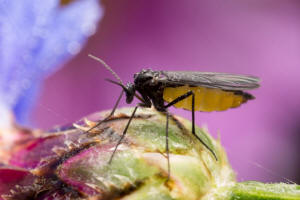|
 Managing
Gnats on Houseplants Managing
Gnats on Houseplants
By Melinda Myers
 Send a link to a friend
Send a link to a friend
[January 19, 2022]
They flit across your face, hover near your
houseplants, or gather by the window. Fortunately, these fungus gnat
insects are more annoying to us than harmful to our plants.
|
|
 This pest finds its way into our homes on plants
added to our indoor houseplant collection or those moved inside
after a summer outdoors. Some may enter on organically rich,
non-pasteurized soil. This pest finds its way into our homes on plants
added to our indoor houseplant collection or those moved inside
after a summer outdoors. Some may enter on organically rich,
non-pasteurized soil.
The small, 1/8-inch adult resembles a fruit fly or mosquito but does
not feed on overripe fruit and vegetables and it does not bite.
Adults live for only seven to ten days, but the female can lay up to
200 eggs in the cracks and crevices of moist soil in that short
time.
Eggs hatch releasing worm-like larvae with black heads and elongated
white or clear legless bodies. The larvae begin feeding in the top
two to three inches of soil, dining on fungi, algae and organic
matter and occasionally plant roots and leaves on the soil surface.
Plant damage is usually insignificant. If conditions are right,
fungus gnat populations can reach damaging levels, resulting in root
damage that leads to wilting and stunted growth. Over and under
watering, over fertilization and other environmental factors are
more likely the causes of these symptoms. Provide proper care to
reduce the risk of this type of damage.
Fungus gnat populations on houseplants seldom reach levels that
require control for the plant’s health and longevity. The adults can
be annoying, especially to the non-gardeners in the family, and are
often the motivation for managing this pest.

Start control by adjusting your watering practices. Since fungus
gnats thrive in moist soil, avoid overwatering. Allow the top few
inches of soil to dry between thorough waterings. Pour off excess
water that collects in the saucer to avoid root rot. Or place
pebbles in the saucer to elevate the pot above any excess water that
collects in the tray.
Adjust your watering schedule with the change of the season. As day
length and light intensity change throughout the year and heat and
air conditioning is employed, a plant’s water needs change as well.
[to top of second column] |

Use containers with drainage holes or self-watering
pots with overflow outlets, also known as weep holes, to avoid
waterlogged soils. Refresh potting mix as needed. Older planting
mixes degrade over time, retaining moisture longer and creating an
inviting environment for fungus gnats.
Manage unwanted fungus gnats with an organic Bacillus
thruingiensis israelensis (BTI) product such as Summit Mosquito
Bits® -
www.summitresponsible
solutions.com
labeled for controlling fungus gnat larvae. Just sprinkle it on the
soil surface and this naturally occurring soil bacterium kills the
fungus gnat larvae in the soil. It’s safe for people, pets, and
plants. Read and follow label directions repeating as needed.
Use yellow sticky traps to monitor adult populations. Place homemade
or purchased traps on sticks in houseplant containers.
Use 1/4-inch slices or wedges of potatoes to attract and monitor
fungus gnat larvae. Stick a portion of the potato into the soil.
Check for fungus gnats after a few days and replace the potato wedge
to help manage this pest.
Understanding the fungus gnat and its preferred environment will
help you safely and effectively manage this pest.
Melinda Myers has written more than 20 gardening books, including
The Midwest Gardener’s Handbook and Small Space Gardening. She hosts
The Great Courses “How to Grow Anything” DVD series and the
nationally-syndicated Melinda’s Garden Moment TV & radio program.
Myers is a columnist and contributing editor for Birds & Blooms
magazine and was commissioned by Summit for her expertise to write
this article. Her web site is www.MelindaMyers.com.
[Photo courtesy of Summit Responsible
Solutions]
 |